The FPJ-IMC Forum
presents a Panel Discussion on
Solar Power: The Agony & The Ecstasy
held at the IMC, Mumbai, on 10 June 2016
http://www.freepressjournal.in/fpj-imc-forum/spotlight-on-solar-energy/871958
A pdf copy of this event can be downloaded from here2016-06-16_FPJ-IMC-Forum-solar-Power-online-edition
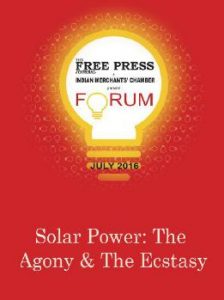 The Policy booklet can be downloaded from here Solar Energy booklet – low-res version
The Policy booklet can be downloaded from here Solar Energy booklet – low-res version
Solar power – Little agony, great ecstacy
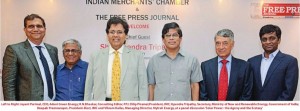 The idea of renewable energy as a significant contributor in the power supply pie was treated with a lot of condescension for most of the past decade. It is only in this decade that the concept has caught up worldwide and many projects are being planned on rates as low as under 3 cents/ unit of power sold. As an alternative to fossil fuel based energy, its economical, ecological and social value is now fully appreciated. India has a natural geographical advantage in solar power and wind too. Now the question is not whether, but how soon, India can, embrace solar power. Its hurdles will be legacy thermal power production base, coal reserves in India’s mines and practical ground issues relating to land acquisition.
The idea of renewable energy as a significant contributor in the power supply pie was treated with a lot of condescension for most of the past decade. It is only in this decade that the concept has caught up worldwide and many projects are being planned on rates as low as under 3 cents/ unit of power sold. As an alternative to fossil fuel based energy, its economical, ecological and social value is now fully appreciated. India has a natural geographical advantage in solar power and wind too. Now the question is not whether, but how soon, India can, embrace solar power. Its hurdles will be legacy thermal power production base, coal reserves in India’s mines and practical ground issues relating to land acquisition.
To discuss this, the FPJ-IMC Forum organised a panel discussion with experts at the Indian Merchants Chamber, Mumbai. The keynote address was given by Upendra Tripathy, Secretary, Ministry of New and Renewable Energy, Government of India. The panel comprised Jayant Parimal, CEO, Adani Green Energy and Vikram Kailas, Managing Director, Mytrah Energy. The event was moderated by R.N.Bhaskar of FPJ with editorial support from Pankaj Joshi.
The welcome address was given by Dilip Piramal, the outgoing president, IMC, and the vote of thanks by President-Elect Deepak Premnarayen.
Dilip Piramal: In the last two years, the Ministry of Coal – Power, Coal and New and Renewable Energy under the Honorable Minister’s able leadership has transformed the power sector with comprehensive reforms. The Ujwal DISCOM Assurance Yojana (UDAY), with the aim to turn around loss-making DISCOMs across all states is just one example. Under UDAY, bonds worth Rs.1 lakh crore were issued in 2015-16. In the past year, more than 7,000 villages were electrified, way above the targets. This ministry is helping India run the world’s largest renewable energy program with target of 175 gigawatts by 2022.
Shri. Piyush Goyal, the Minister, launched the Surya Mitra mobile App last week which aims to create employment opportunities for skilled manpower in installations, commissioning, operation and maintenance of solar power plants and equipment.
Clean and green energy in the form of solar power is the major energy source. Our country is endowed with unlimited solar energy. The way solar energy prices are going down and technology is developing, energy costs can become very low. We may even go to days of even free energy, something quite unthinkable even a few years ago.
There are challenges, however, to the Government of India’s vision of connecting the unconnected and 24×7 affordable and environmentally friendly power to all – such as getting all states to sign up for the UDAY agreements, connecting remote villages, upgradation of infrastructure, new technologies and improved efficiency in order to reduce costs. Today, the panel will discuss the entire gamut of challenges and the opportunities in the solar segment.
FPJ: Thank you, Dilip. Could I also request Ashok Karnani to hand over a small memento on behalf of the Free Press Journal to the Secretary and the panelists? Thank you very much for coming over.
I also have a very unusual request of the Secretary, Upendra Tripathy. This will be possibly our last panel discussion under the present President. We have started in the month of January and in six months, we have covered six discussions, at the end of which we have come out with policy reports. Each panel discussion has met with a better reception than ever before. Could I request you now to hand over to Dilip Piramal a special memento for making this possible?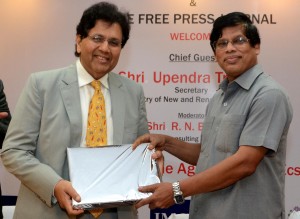
Piramal: Thank you very much. This is a very pleasant and welcome surprise. As Mr. Bhaskar said, we have done about six programs, and each program has been of very high quality, and so has the calibre of the speakers. Today’s program was to be a minister, but we have now the secretary who is by himself very important. And we have had such eminent people as the Chairman of NDDB and the Municipal Commissioner (of Mumbai) and the MMRDA Commissioner. We have had very high quality programs, and it has been a very satisfying experience. I thank the Karnanis, the promoters of the Free Press Journal and, of course, Mr. Bhaskar, who has been the spearhead. Thank you very much.
FPJ: Thank you. Could I now request Secretary Tripathy to make his keynote address.
Keynote address: Upendra Tripathy: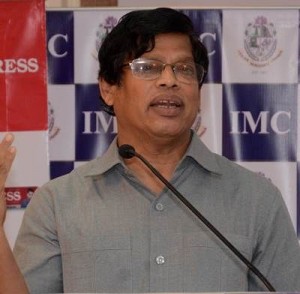
Friends, I am extremely thankful to you all for having called me here. As far as the subject of solar power goes, I find no agony in this. Let me share the journey we had since I took charge on April 1, 2014. In June, the Honourable Prime Minister called me and asked if 100,000 MW of solar power was possible. I replied yes with two lakh sq km of desert in Rajasthan and a country of 120 crore people it is definitely possible. After that when I talked to my predecessor in the office, he replied that it was not possible and there was a three-page letter on file outlining the reasons. That made me nervous regarding my confident commitment to the Prime Minister, more so when I read the letter which beautifully outlined the reasons why 100,000 MW cannot be done – no grid, no land and no money.
Then, I called in all the officers and scientists for a two-hour long meeting, at the end of which a vote was taken. I didn’t vote, but there were 58 who said no and only one person who said yes, which meant that the collective strength of the ministry felt it impossible. I was really devastated because now I could not go back to the Prime Minister with that inference.
At that time we got this new idea – in an energy ministerial confederation in Korea – of a global investor meet for renewable energy and thus Reinvest 2015 was born (though it finally happened in February 2016). While asking the Prime Minister to inaugurate it, we were asked about what was the planned outcome of the conference. We said, “We will go beyond MoUs, we will get commitment certificates from the industry as to how many MW are going to be put up.” Beyond that the question of money came up and again we replied that we would talk to banks and get financing commitment letters as well.
Frankly we had no visibility at that time in either of these areas. But when the event was done in February we had commitments for 277,000 MW, signed by company managing directors. That again was a new challenge because what would we do with 277,000 MW. If all the capacity comes in, again there are issues. And in India, where people give commitments and can wriggle out, it doesn’t matter. But for commitments made from companies of other nations, regulators took note of press reports and started questioning the respective companies.
Those people then came back hurriedly and said our commitment is being monitored, so how do we go ahead. How do we tackle the land matter here where people sell land 3-4 times? That was when the solar park idea came, there was already an example in Gujarat where we provide a centralised mechanism to facilitate your solar power production, make it easier and perhaps bring costs down. It brings a number of companies together and they would feel safer to participate in the process. At Reinvest, we also got signed commitments from 28 public sector banks to finance a total of 77,000 MW. Three days back, we met those banks and we are happy to say the banks have kept their promise, with visibility of around 20% of the money (Rs.88,000 crore). Thus in our 100,000 MW solar venture, Reinvest gave us confidence. We earlier had a commitment of 20,000 MW upto 2022, which suddenly went up five times. That brought in pressure, but it was never agony, more of a challenge and happiness.
The same team, with the same officers sat down to list out the challenges, starting with the land issue. The cabinet secretary took multiple meetings and one of the earlier outcomes was that we said if land was to be an issue, we could take out 40,000 MW of this and put that on rooftops which would not require land. The finance minister was very comfortable with this. Then was the issue of how to get money. We don’t have a very friendly bond market, no green bonds, and no payment security mechanisms. Essentially, we did not have innovative financial mechanisms in India which could finance 100,000 megawatts. What we had in hand was only the promises of domestic banks. No foreign bank till date has given any money for renewable, but we have had brilliant support from both public and private sector banks. I would like to understand the constraints that foreign banks face in this regard.
On land issue, we thought that, despite the Land Acquisition Act not coming through, the local governance offered quite a few mechanisms for land acquisition. Today, I am proud to say that Karnataka has some 2,000 MW on nearly 10,000 acres of land obtained through lease from a society which was just created by farmers. There was no acquisition or notification, just a lease out of land to the park.
Other questions came up – are there sufficient engineers and trained mechanics to attend to park or rooftop requirements on regular basis? Are there independent power producers (IPPs) with agreements? Then came the material and components question. Overseas there is not much of the dust issue, but in India panels need to be washed every few days. As of now we import nearly all the material – around 73% from China and 17% from Malaysia – and the notified anti-dumping duty of 45% would make our target more difficult to attain. Localisation will definitely take some time. Somehow we haven’t been very well with silicon, whether it is the computer chips or whether it is solar panels. There was a question of quality testing, of lab infrastructure in the country at that time.
One idea we had of having 50,000 mechanics to be trained, which today we call Surya Mitra. Like a taxi service, you can go to the app and give information, whereby a mechanic will contact you and charge you Rs.150 as per rules. Of course, it is to be clarified whether this would include the conveyance, but I would say be kind and do not just hold on to the Government-notified figure.
Our minister, apart from being a lawyer, is also a chartered accountant and his financial knowledge has helped the states to patch things up, to get money from the ministry. In just two years’ time our budget has gone up six times from Rs.1,500 crore to Rs.9,000 crore. Then you look at the carbon cess, which has gone up from Rs.50 to Rs.400 and that also has partly helped us get money. The RBI stated that upto Rs.1,500 crore investment in renewable energy would be treated as priority sector lending. Rs.10 lakh proposals in the rooftop segment would be priority sector lending.
The other day we had a meeting for how to finance 10,000 unemployed graduates and we could give them say one MW each and make them solar entrepreneurs. We never thought it would be so easy to achieve, hence there was no agony. Today if I am asked for 100,000 MW I am sure we can put that in place in eight months. For instance, in Andhra Pradesh and Telangana, solar is popular because people have figured out that thermal is equally costly (in capital), it takes four years to get started and you have to keep on buying coal. Here you get started in eight months and then for 25 years you do not have input costs.
Now coming again to land, if you want to find 100,000 acres of land parcels in one place or in a few places, it’s difficult. But if you just take the count of 11 KV substations in the country, or for that matter 33 KV and distribute 100,000 among that, each place will come around 2 MW. You then don’t need long connectivity lines, nor do you need a lot of green energy corridors to take it. You can easily put 100,000 MW on the grid, in all those tail-end areas where it is precisely needed. Regarding technology, in Australia they have started 3D printing of panels, solar panels at a speed of around 10 metres per minute. The way technological innovations are coming up is also getting capital costs down.
The next question is finding the buyer. Getting the states to buy is a matter of concern for them. At the rooftop level, you can produce 40,000 MW, but if I tell them can you buy another 20,000 MW they refuse because they are saturated. In fact, their main paying clients could get away because rooftops give them access to their own power. So, the states are worried that renewable energy, apart from forcing them to buy costlier power, can also get their best customers moving away from them. States also now feel that industrial tariffs have to be brought down in line with international practices where industrial power (being a bulk user) gets good rates and domestic tariffs are 4-5 times higher.
In India, it is the reverse – as evident from the coconut story. A retired person from an energy utility started selling coconuts and when asked the price by prospective customers, he would ask them the purpose of the coconut. Based on whether it was intended for use in a temple, a hospital or a household, he would then quote different prices for the same coconut. So, overall persuading states to buy renewable energy have been a challenge. However, we do have the famous Renewable Purchase Energy Obligation and many states have respected this and made sacrifices. In the ministry, for example, in 2010 we tendered the first lot of 88 MW of solar power for Rs.18 per unit, which means we pay Rs.200 crore subsidy for that lot of power and we have promised to pay it for 25 years.
Gujarat made a lot of investment in solar without taking money from the Centre. They started selling at Rs.12-15 and when I joined the ministry it was Rs.7-7.50.Today, you have Rs.4.34, it is sustainable. The proof of sustainability is that with good brains and good mathematics, many people participate. Corrective mechanisms do play their part, like in Karnataka the viability gap funding (VGF) has gone up from Rs.50 lacs to around Rs.72 lacs.
This year we will do 12,000 MW and have tendered for 20,000 MW. Another 20,000 MW is being brought in through solar parks which are centralised production, meant to attract more foreign players. And perhaps the 40,000 MW of rooftop installations may partly be shifted to ground base as needed over a 2-3 year review. Today, Delhi Metro plans to produce 500 megawatt in Madhya Pradesh, bring it to Delhi and use it for the metro. The Honourable Chief Justice has asked us to ensure that the Parliament, the Rashtrapati Bhavan and the Supreme Court, all three become 100% solar, be it through own rooftop or purchased from elsewhere.
It is not just any subsidy, people are becoming conscious of the benefits of solar energy, of how would we leave the planet for our grandchildren. Every MW of solar means 50 vehicles off the road, 2% lesser premature deaths caused by air quality. So if you are an active partner – a company, a consultant – playing a role in this revolution, you should be proud of it. You are a proud partner in the revolution of what we call oil in the sky, oil on the rooftop. That is the way solar is addressed these days, and there is technology, there is finance to help us to exploit it. Like the German gentleman making Ritter chocolates who felt one day that he was making enough money and now he would rather do something social through solar power, all corporate players must do their bit to promote and undo what we have done in the past. Thank you.
FPJ: Thank you, Mr. Tripathy. It was a very illuminating talk and now to some questions. First, what is the policy of the government about waste to electricity projects?
Tripathy: As per the Kasturirangan Report waste to electricity should be under the Urban Development Ministry, though we still look after the technology part. The policy right now is that, in notified cities, if anyone gets electricity from waste, it shall be purchased and in case of multiple parties there will be some sort of reverse bidding. So that is an assurance. However, they say that Indian waste is unique, because in case of plasma technology it eats up the waste but Indian waste is so peculiar that it eats up the plasma. In absence of segregation and quality of waste, the technology then will need a lot of local collection efforts. However, the plans being discussed, and enquiries coming in, this is an area where improvement will happen.
FPJ: Can the Ministry of Energy make it possible for central government undertakings to adopt rooftop solar and make sure that we use rooftop solar so that becomes more popular?
Tripathy: Recently, there was a pan-India workshop with 800 participants including all secretaries from states. Three days prior, Government of India’s 45 secretaries had given a commitment letter of an aggregate contribution of 5000 MW. Atomic energy ministry committed for 50 MW and even, the department for personnel and training had put in a commitment for 2 MW. We are proactively going around having discussions with departments, and that is when they found out that rooftop model is cheaper in many places. In the end it is about accountability, if it is cheaper and yet it is not implemented they are vulnerable to queries. It is common sense, if your rooftop is empty and you have savings of Rs.3-4 per kilowatt hour like Delhi Metro, you should go for it.
FPJ: Mumbai is an expensive city and here what incentives do you have for societies that put up rooftop solar? Can we get extra FSI?
Tripathy: Some cities do give extra FSI, but that is ultimately a municipal government issue. We have written to municipalities to give enough incentives. In some places like Gurgaon it has been made compulsory, on the other hand, places like Pune and Bengaluru have it compulsory for water heaters.
A society can go to our website, give a small tender and discuss with the respondent that how it can be done when the society does not have money to invest. The respondent company may say that they might do it for you without cost, but you will have to get into a civil enforceable contract to buy power for 25 years at a rate attractive vis-à-vis your current cost. That way you get rooftop solar and five years maintenance free, in which time you could learn to do the maintenance yourself.
FPJ: Are you working very closely with the Road Ministry and for LED bulbs to be installed along highway? Wouldn’t it make sense to combine street lighting and renewable energy?
Tripathy: We all work together on a WhatsApp group of 84 secretaries. Around 10.4 crore LED bulbs have been installed. State governments have come up with new programs and the Ministry of Power has made it very popular. In many countries, the energy conservation and renewable energy are in the same ministry. In India, we have two different ministries but under the same minister and we work closely with each other.
FPJ: Thank you very much. As you can see the things that Secretary talked about was far, far more interesting than what we had imagined. Every pain point that the industry was supposed to have, was quietly dispelled. We have a magnificent policy overview of what the ministry is trying to do.
We now begin a panel discussion on the nitty-gritty of solar power. Here are two people who are setting up power projects, who know very clearly where the shoe pinches. They know some of the pain points and, of course, they also see the opportunity. Could they spend a few minutes talking about what their companies are trying to do and then I will go on to the questions.
Jayant Parimal: I head the Renewable division of Adani Group, the largest conventional private power producer which is operating approximately 11 gigawatts (GW) right now. We are acutely aware of climate change issues and the importance given to clean energy and renewable energy by the Government of India, with a renewable energy target of 175 GW. We had a 40 MW solar plant in 2011 which was then the largest though it sounds very small today.
During Reinvest, we gave a modest commitment of 6,000 MW and after that we started looking at this sector seriously and right now our aspirations are big. We want to be end-to-end in the chain, which includes manufacturing of solar panels and related activities upto development of the power plant. As we speak, we are constructing the country’s largest solar manufacturing plant at Mundra, which is 1.2 GW megawatts cell plus module, which will go to 2 GW in phase II expansion. Coupled with that is manufacturing of what is called ingot and wafer and backward integration upto poly silicon which is the goal.
On the development side, 15 GW is our aspiration – 700 odd MW is set up, and 1,300 MW more is under construction. That makes us already the largest player in India and at 5 GW we will be the largest worldwide. India does not have a system wherein you can have a PPA signed and start construction. We have to bid under Central/ State Government schemes, which come out every month. We win some bids and lose some, hopefully we will be able to win 15 GW equivalent in the next five years.
We have already built the world’s largest single-location solar power plant in Tamil Nadu which is 648 MW spread over 3,000 acres. The Chinese are in the process of building a 2 GW single-location plant, but 648 MW is a very big number by Indian standards. Apart from that, 2 GW solar capacity is under implementation and we are also setting up solar parks, MIDC equivalent, wherein we give plots to prospective solar power producers. We are developing one park in Rajasthan (10,000 MW equivalent) and in Gujarat (30,000 MW equivalent). Wind power is an area where we have similar aspirations.
FPJ: Vikram, could I have your perspective of what your company is doing?
Vikram Kailas: Disruption and energy don’t go in the same sentence, but what we have done is to play the role of classic disruptor and take a lot of initiative to participate in the creation of this sector. About five years back, when I started this company, nobody even understood what wind and solar is and that it actually generates power. It was more of a tax instrument that people bought. Wind or solar was not used in the same sentence as power generation ever, the way it is today.
So, we contributed to creating this industry. Nationwide we are the largest in wind energy, with 930 MW of operational wind power and 700 MW solar power is under construction which would be operational in a year.
As a company, we don’t have any grand visions or missions. I’m a big believer in 30-day or a 60-day business plan. In this ever changing world, I am not going to commit to anything until the rest of the thing sort of comes together. We never thought solar would reach the levels of pricing that it reached today with 75% drop in cost in the last four years. So, we don’t make plans written in stone. Every 60 days we evaluate our plan. Our plan depends upon oil prices, interest rates and changing scenario in Siberia, Russia and the US. We rub the slate and rewrite the plan all over again.
This is a company that’s young and aspirational, but at the same time wants to contribute to the society in a large way rather than just being the largest or biggest. We have a different ethos, we have donated all our shareholding into a trust and if we sell the company the entire money will go to charity. We are dreamers, but we dream with our eyes open.
FPJ: Thank you, your approach is refreshing. Now we come to the questions. On policy, every solar producer prefers to bid for the central government JNNURM projects, rather than the state government projects. Could both of you throw light on this?
Parimal: The reason is that counterparty risk is significantly different. Most DISCOMs are not in good shape, they are unable to pay regular bills of our thermal power plants which are only Rs.3-3.50 per unit. Solar power would be significantly more expensive. Though the Central government has now come up with UDAY scheme and we believe that things will change, but as of now counterparty risks are fairly high, so we don’t want to have a PPA with the state entities.
In case of Government of India controlled entities, right now the counterparty is NTPC which has an excellent balance sheet so risk is fairly low. Solar Energy Corporation of India again is an MNRE controlled entity so the pseudo-sovereign guarantee is there, although not written in a PPA. This is why most of us prefer to bid and bid aggressively in these entities. We are not in wind but Vikram is and he knows how Tamil Nadu or even Maharashtra government entities delay or try to cut down the payment. We too have the world’s largest solar power plant, but are being backed down on a regular basis and not being paid in time. With this behavior, risk premium goes up and banks too get reluctant.
Kailas: At the end of the day, State Governments are bankrupt, and then land is a big issue. In solar parks, the government gives you land, a PPA with NTPC and they say here is the evacuation infrastructure. There is limited risk, strong counterparty and I can easily do my part of putting in panels. So, there is some substance in the concept of solar parks, and of course you can do large scale at one place.
FPJ: While setting up a solar park, with huge companies taking up the solar power that it produces, is there less of a counterparty risk?
Kailas: Let’s step back a little, to what Mr. Tripathy was saying. Because of the cross-subsidy, it is easier to distribute solar power and industry pays lower, but the after-effects should be considered. You take away lucrative customers from the utility and tell the utility to earn money from the non-lucrative customers. It’s a small problem but it is causing disruption. In 3-4 years, with battery prices and panel prices still on a falling curve, we can generate electricity on top of our houses.
So then how to separate the loans from the utility at such time? This is a much larger issue that we as a country and a power department have to resolve. The environmental issues of coal-based electricity are true but at the same time these are funded projects where people have put in money and banks have lend-out money. Are we going to honor those contracts?
That is the motive behind a lot of electricity boards that are not giving permissions for what is called open access, or are putting artificial charges for open access – so that you do not take away the lucrative customer. There is a much larger canvas to look at and discuss in a 20-30-year format for a solution.
FPJ: Brilliant. Taking off on battery prices, they are falling dramatically. They are expected to be less than 25% of current costs. With that, solar power does not have the uneven flows but instead gets stabilised from the battery and reaches the grid in a clean form. The biggest threat to that is existing coal-based thermal plants where again Adani is a player and the country itself has huge capacity. Do you see attrition between a cheaper vibrant solar power and the legacy coal-based power?
Parimal: That’s a few years away. We have already seen a price-based revolution in solar power generation – because of technology and market forces. In Dubai, somebody quoted US$0.0299 per unit where we were also to bid. We cannot understand how they worked it out, but such bids are indeed credible, the project is coming up. So in a year or two down the line, we are looking at that range of prices. Solar power prices will fall, at what speed is debatable, but the bottom has not been found.
Today, solar power is intermittent, unstable and comes in the day. Storage is the answer which right now is expensive. It costs Rs.10 per kwh to store electricity, but as we speak prices are falling 20% every year, so in 3-4 years solar plus battery storage and wind plus battery storage will be a reality, starting from developed countries where cost of debt is fairly low. India has high-cost debt so it would take a few years longer. In USA or Dubai, you can generate power at $0.03-0.035 and store it at $0.04. Basically, you have a delivery price of $0.075-0.08. Hence in such places, you will have houses or industries which are 100% on solar or wind energy. But in India, it will take more time, because cost of capital is high and if we add 12% interest it becomes more expensive.
On solar parks, they are purely real estate kind of stuff; the only thing they resolve is the risk of land and the risk of evacuation. The counterparty risk does not come in play because we as solar park organisers do not buy the power. It is sold by the solar power developers though some DISCOM or some third-party. Two risks are taken away – land risk and evacuation risk which both are big because they can delay execution which people normally aim to complete in around 12 months.
FPJ: Do you have a ballpark figure for cost when a builder provides solar panels on the rooftop? Also would there be incentives that State or Central governments could provide to make solar panels cheaper and installation easier?
Parimal: On a thumb rule, a rooftop should cost you Rs.60,000 per kilowatt. The Government of India has a simple 30% subsidy scheme where I am not aware of how simple the process is. And it is a viable project because many states have net metering installed, only thing is that the DISCOMs are no longer making it easy to get net metering installed, just because they think that the good and paying customers will go away.
FPJ: When you look at solar power already the pressures are evident in the United States where just a couple of months ago 20 PPAs have signed at under $0.03 a unit, much lower than Rs.4.50 that India tariffs are. So do you expect another 30% to 40% reduction in solar tariffs in India?
Kailas: There are several factors playing a part. In Dubai, there is no income tax which is a 30% differential straightaway. In the USA, there is a lot that happens in investment tax credit and production tax credit, below the EBITDA line. It includes lower cost funding, long-term funding and lower counterparty risk. Then, there is the land and permits process which is more streamlined, predictability of project costing and so on.
Having said that, the straight answer is that costs are still coming down and it would not be a surprise to see in 3-4 years power cost levels of Rs.3-3.50 in projects without battery storage. It’s not as if India has not seen those prices when projects started but those were seen as expensive because coal-based power was Rs.2-2.50 at that time. Prices are also influenced by comparison, solar prices are flat for 25 years and there is no pass through like in thermal or gas-based power projects. And when we sold solar power at Rs.3.50 four years ago we did make money on those projects, and we break-even today.
Parimal: In economics terms, a fixed 25-year purchase price is deflationary – be it solar or wind. Hence, even if it looks a little high today, when you discount it by inflation over the term, it is deflationary.
FPJ: A question which comes up is that, that even though the price of solar power is coming down, the state government doesn’t want solar power to take away its most lucrative customers, so it adds on all kinds of arbitrary charges whether it’s the Bombay Excise Duty Act, BEDA or it is commitment charge. There are various kinds of charges that would had make sure that solar power is not viable and does not disrupt the existing pricing mechanism. How long do you think the government will take to arrive at a rational power policy, which also means doing away with some of the irrational subsidies that are in place?
Kailas: And can you believe that after all this the electricity boards are bankrupt? Maharashtra has not paid people for one year, nor has Rajasthan, despite having monopoly and charging so much money, cess and so on. It was what happened with telephones where BSNL in an ad said we have satisfied all the demand. At that point, there were 10 lakh landline connections and BSNL was playing the role of a regulator, implementer and disruptor. Today, there are so many conflicts of interest in the system and you need someone to say now let’s leapfrog to the next generation. That is the role that the government is playing.
One of the major differences is that BSNL didn’t owe a lot of money to banks, so the official forces could have supported disruption and moved on to make cellphones the reality. Today, all the electricity boards between them owe banks probably Rs.3-4 lakh crore. So, the authorities need to first find a way to make the banks good for that money, and then they can force disruption, which is a right thing to do also. This is the right time for the boards to pay down the debt and get away with the subsidy, because oil prices are low and we are running revenue surplus.
Also, I think so how long will it take for all of these guys to pay down that debt and get away with the subsidy. The country has to take a decision on how they are going to use this money to create a much larger and better future.
Parimal: The new act is already with Parliament, which aims to bifurcate the electricity business between carrier and content. So with that the DISCOMs will get sorted out, get paid an assured sum for the wire network where the content can come from anywhere. After that, if they put obstructions, the technology will bypass them, the way mobile wireless technology bypassed BSNL.
In the late nineties, I was working with a state government trying to set up an ISP and BSNL was being an obstacle, because the owned copper wire network at that time was not so well known. When we tried to send it to each house through copper, they refused us access. What happened 16 years down the line is that copper has been bypassed through a technology directly using 3G and 4G at several mbps. So if the state entities do not improve, then in all those Tier II – III cities where growth is horizontal, solar technology along with storage will bypass these DISCOMs and people will become independent in energy terms.
FPJ: With the rapid expansion of solar power, do you find the people with the skills that you need? Is the government doing enough work on the skill development front or is industry creating the skills that are needed? Second, in India current efficiency of funds is 10-14% whereas overseas it’s 32 to 35%. When do you think India will reach a better cost efficiency of funds?
Kailas: The first was skill development. The beauty of wind and solar is that I can check on my app right now what my wind plant or solar plant is generating at this point in time. It is not as complicated to operate a wind farm or a solar farm as it is to operate a gas plant or a coal plant. This is an industry that will give jobs to the kind of people that need the jobs. You don’t need to hold any Ph.D. or be an engineer. It only needs a manual and then it is a nuts and bolts job. However, there is a lot of work on the data analytics side in terms of improving performance, so it gives jobs to the data scientists also. All said, it is a simple industry to manage.
On the efficiency part, I believe both wind and solar efficiencies in India are among the highest, primarily because we have so much sunlight and so on. Wind efficiencies have already reached 31-32%, with improved technology. In 2-3 years, we are going to talk of 42-45% efficiency. In case of solar, if we can integrate solar and storage then in 4-5 years you will have hybrid plants with 60-65% efficiency levels.
FPJ: Thank you. You both have been extremely helpful in making a complex subject of solar very easy for all of us. Could I request the Vice President – President (Elect) of IMC to deliver the vote of thanks?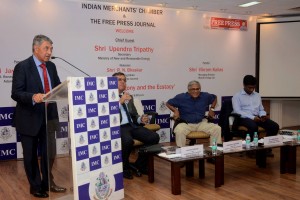
Deepak Premnarayen: Thank you both the panelists, and the secretary too, who spoke about foreign banks. All I would like to share is that I know of two foreign banks launching renewable energy funds of $250 million. Also recently, the Harsh Mariwala foundation, which hosts an Innovation Award Event every year, had given away a special award to a gentleman. His company supplies the solar equipment and they do get into this 25-year plan, which means that there is no capital cost and effectively, a depreciating cost of power (adjusted for inflation). Thank you.






























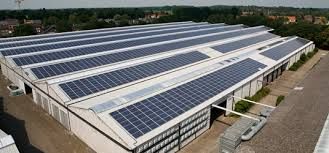







COMMENTS